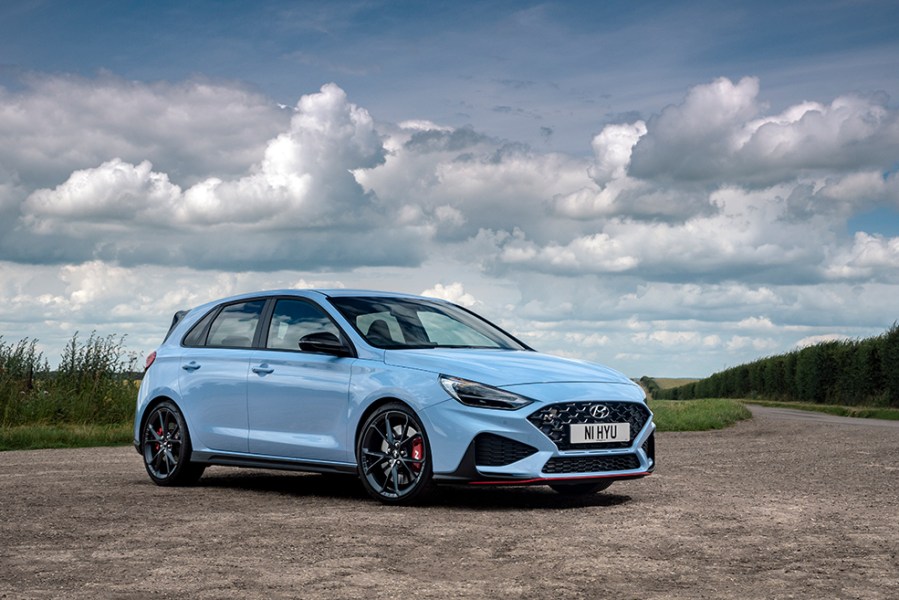The Hyundai i30 N burst onto the scene in 2017 and took the hot-hatch world by storm, here’s what you need to know before buying the Korean pocket-rocket.
Quality and Korean cars go hand-in-hand today. For some who grew up in the 1980s and ’90s, this can still be a hard thing to reconcile – that the likes of Hyundai and Kia can have evolved from being the then-equivalent of, say, Skoda, into market leaders seems like an incredible achievement. Time changes everything of course, and Hyundai and Kia have become two of the most significant motoring names across several sectors. And when Hyundai wanted to chase after more sporting consumers, it’s telling that they were able to poach Albert Biermann from BMW’s M division to oversee the development of the Hyundai i30 N.
There were to be no half-measures here, this thing had to be a genuine contender.
Hyundai i30 N history
Launched in 2017, the Hyundai i30 N was a crisply styled hatchback with a 2.0-litre turbocharged four-pot putting out a nice round 250bhp. Serving up 260lb.ft, the 0-62mph dash is dispatched in 6.4-seconds with a top speed limited to 155mph. The handling is keenly tuned to provide both comfort and superlative dynamics (and it’s significant that the N in the name stands for both Namyang, where the company is based, and Nürburgring, where this car was developed), and everything is minutely customizable via the Custom mode – suspension, rev-matching, throttle response, stability control, steering feel, the works.
Much as other manufacturers like to offer up-specced versions of performance cars (and Hyundai were keenly observing Volkswagen’s ‘Performance’ and BMW’s ‘Competition’ here), an i30 N Performance was also offered: power increased to 275bhp, torque rose to 279lb.ft, 0-62mph was down to 6.1s, and it also came with a limited-slip differential, 19” wheels and an active variable exhaust.
From 2019, a new body style arrived – the Hyundai i30 N Fastback. With a coupe/saloon profile, the dynamics were just as vibrant but there was a little more luggage space, and every Fastback for the UK market had the full-fat Performance pack.
With the i30 N having been available for a few years, there are some proper bargains to be had on the used market. While brand new showroom prices start from £34,000, early examples of the model are now starting to dip to the £17,500 mark. It’s also worth noting that, with Hyundai’s five-year warranty, it’s perfectly possible that you’ll be looking at cars which still have a decent chunk of the warranty left to run.
If you want a piece of the N pie in the US, you’ll need to scratch the itch with the Veloster N. Similar performance, but in a less-practical package.
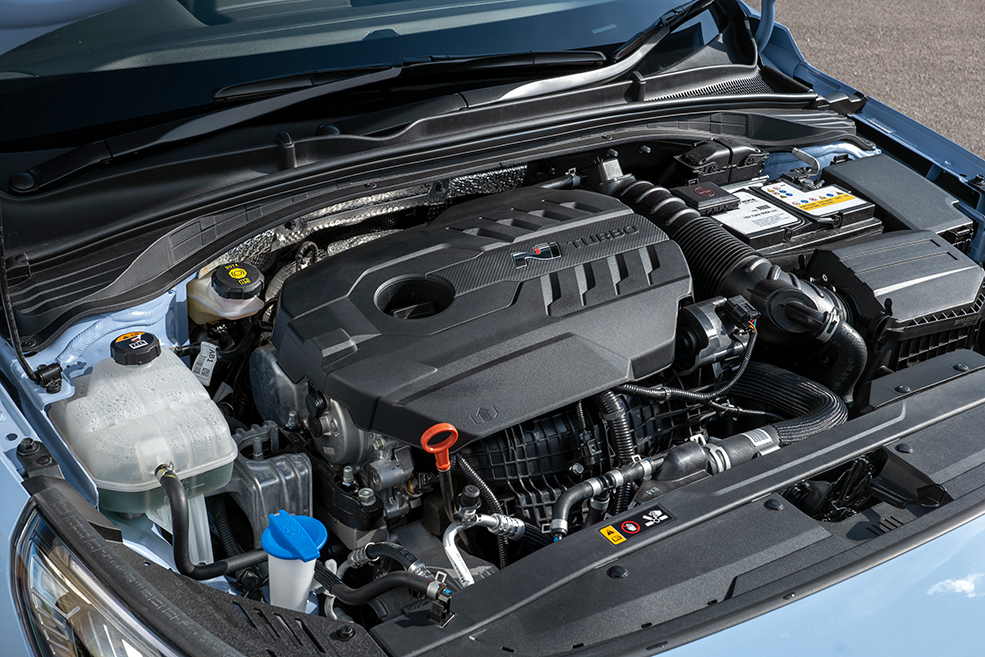
Hyundai i30 N most common problems
- Faulty fuel pumps or loose battery terminals can trigger engine warning lights
- The interior can suffer from rattles and noises, generally from the dash and headlining
- Infotainment systems can sometimes be a bit glitchy, although it’s often fixable by the timeless ‘turn it off and on again’ trick
- Check panel fitment and paint finish closely for signs of accident repairs – some of these cars live a hard life
- MY18 cars were recalled due to issues on start up and power delivery down to loose battery terminals

Hyundai i30N Buyer’s guide
Engine
The engine in this car is a real masterstroke. Part of Hyundai’s Theta engine family, this one is a 2.0-litre 16v turbocharged twin-cam that delivers its power in an amusingly old-school way. It’s easy to get used to the way turbocharging has integrated itself into modern power delivery, but anyone who grew up in the era of RS Cosworths and GT Turbos will appreciate the tantalizing thrill of a little smidge of lag followed by a kick in the back, and it’s this classic turbo thrust that the i30 N delivers.
It’s not a totally unburstable unit, and some owners have reported engine warning lights illuminating which turns out to be attributable to either a faulty fuel pump or, more simply, a loose battery terminal, but if you’re still in warranty then this shouldn’t cause too much heartache.
Transmission
The six-speed manual transmission is a sweet and slick-shifting unit. Some owners have experienced problems selecting 5th and 6th gear, but there’s a known fix for this and that’s to replace the synchronizer rings. And while the car’s e-LSD is great in stock tune, bigger power cars would benefit from fitting a Wavetrac ATB LSD.
From 2021, Hyundai offered the i30 N with the option of an eight-speed dual-clutch tranmission. Dubbed N-DCT, it shaved 0.5 seconds off the 0-62mph time, completing it in 5.4 seconds. Not only was this down to the automatic gearchanges, but also due to the shorter ratios.
There was also an ECU recall for 2018 model year cars due to issues with engine startup and power delivery. While some were rectified by simply tightening loose battery terminals, it should have been looked at by an authorised mechanic.
In Australia, the 2021-2022 i30 N cars were also recalled, this time due to an issue with the twin-clutch automatic gearbox. It was a simple gearbox software update that would solve the issue of cutting power between gearchanges.
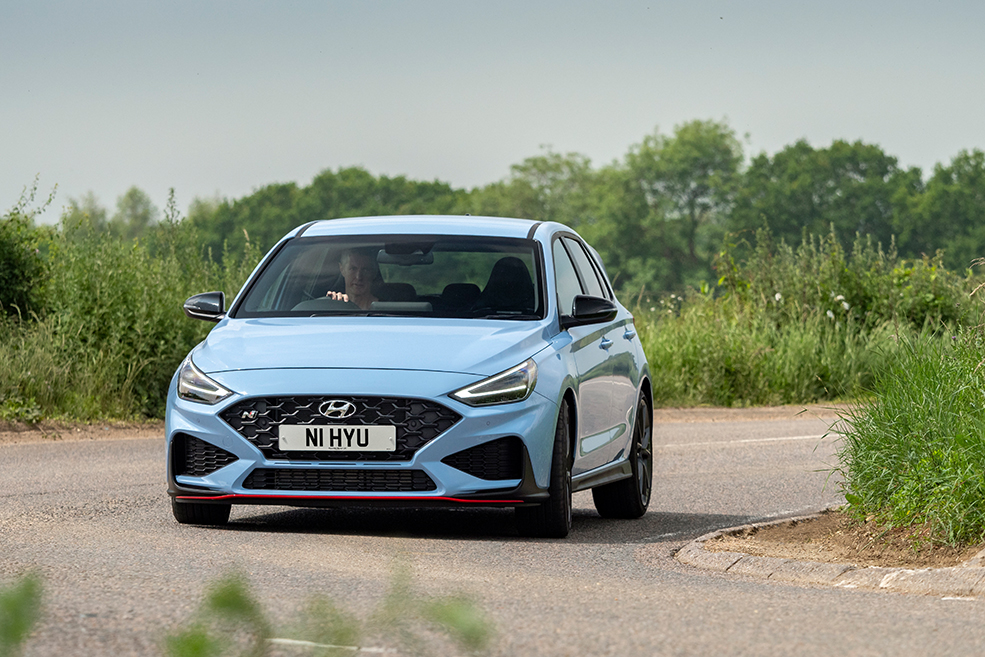
Chassis
The handling of the i30 N in stock form is pretty stellar – the ride is firm but not annoyingly so, the turn-in is superb, and with the Performance variant being around 10mm lower, the stance is perfectly acceptable. But there’s always potential to make things better, and once again we find that the aftermarket is all over it.
I30 N Performance models were equipped with a removable rear strut brace and larger brake discs, which make for no-brainer upgrades to non-Performance i30 Ns. Given how good (and how clever) the stock suspension is, the only benefit you’ll find from replacing them is with something track specific and high-end. If you’re going for show car lows while also retaining good handling, the H&R Ultra Deep.
In terms of brakes, the factory stoppers are really quite impressive so for road use there isn’t much to be gained from upgrading them unless you’re tailoring your car for track work.
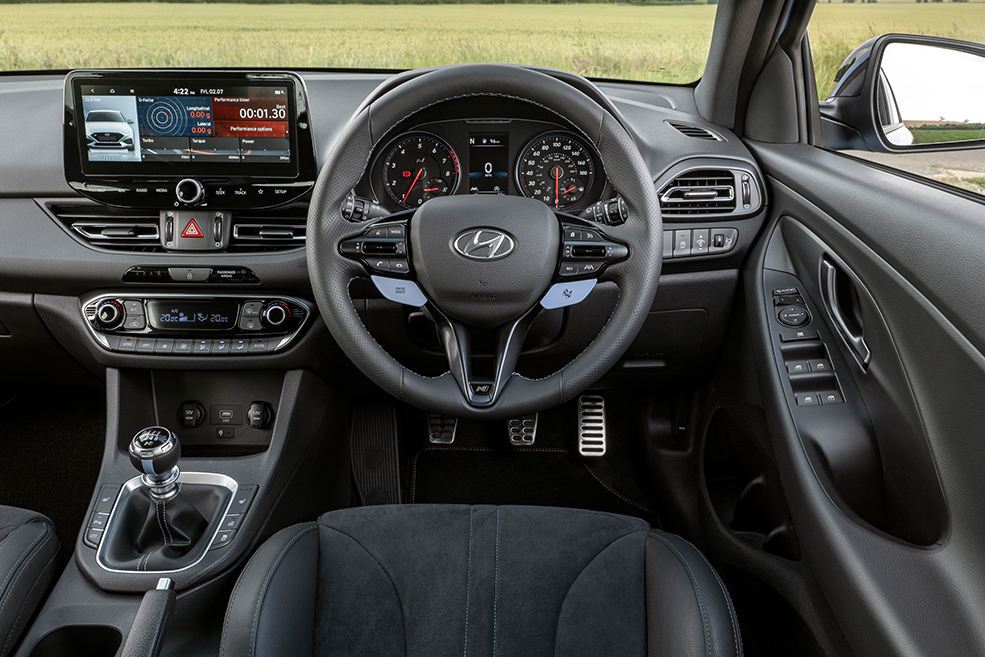
Interior
The spec list of the Hyundai i30 N is highly impressive, testament to the over-arching aim of poaching VW customers: in addition to the superb N-specific seats and switchgear for customizing all the settings, you get an 8” touchscreen, sat-nav, automatic climate control, front and rear parking sensors plus a reversing camera, keyless entry and a handy wireless charging spot. Buyers opting for the Performance variant also enjoy heated half-leather seats and a heated steering wheel; the seats are electrically adjustable and have memory function, although they were also a delete-option so you could have the regular non-electric cloth seats and save 13kg from the kerb weight.
It’s a good quality interior, although there are one or two issues to be aware of, mainly concerning the infotainment system: the screen can randomly go blank, and the volume can fail to fade back up after phone calls. You might also find irritating rattles coming from the dash and the headlining – the former is a fit-and-finish issue with the dash trim, while the latter is down to the wiring for the interior roof lights not being secured and rattling around.
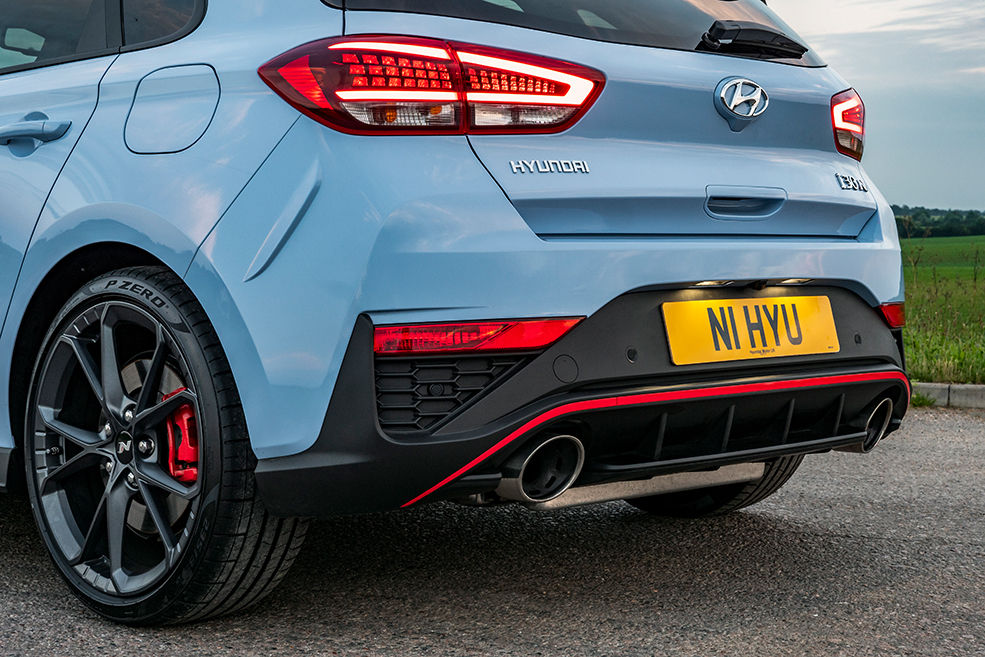
Exterior
The N division’s signature scheme of baby blue with red details is a strong look for the i30 N, and it looks particularly taut and up-and-at-’em with its standard-issue diamond-cut 18” wheels (19” on the Performance). LED headlights are standard on all models, and the spoilers and diffuser are subtle but purposeful.
There are no quality control issues to speak of, so any irregularities you spot in terms of poor panel fit or imperfect paint match will be down to accident repairs – and these are cars that get driven boisterously, so there are some out there with skeletons in their closets.
Styling options on the aftermarket are many and diverse: if you really want to make a statement, the widebody kit from Prior Design is very well conceived and has a proper Touring Car vibe.
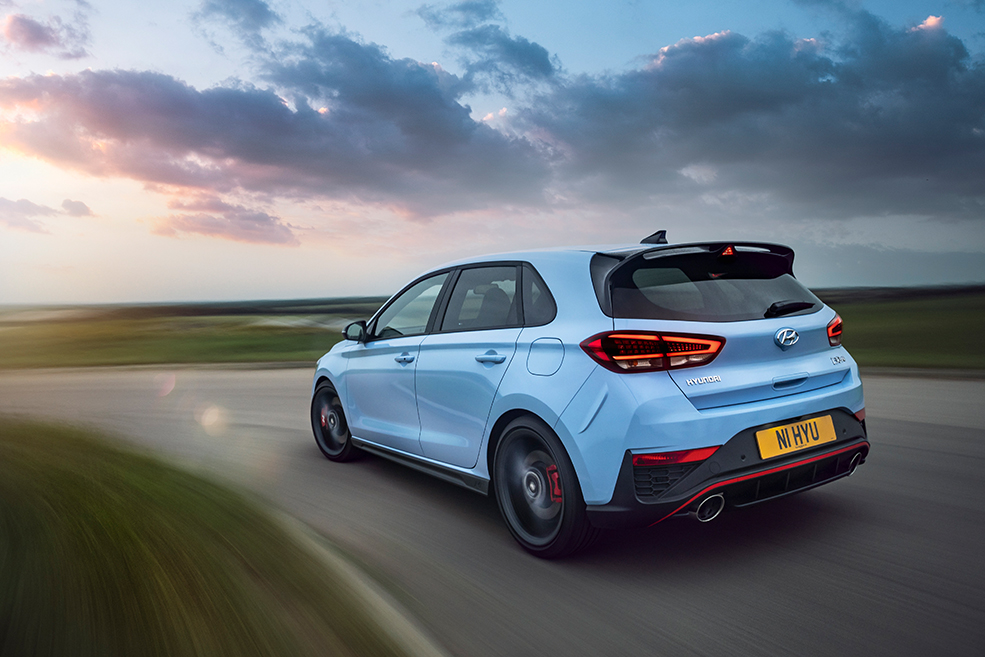
Hyundai i30 N modifications
It’s fair to say that the tuning aftermarket has embraced the Hyundai i30 N with gusto too. There are some superb stainless exhaust upgrades on the market, including those from Scorpion and Milltek, while the other end of the breathing structure can be aided by an induction kit from Airtec or Forge. Indeed, Forge are particularly keen on the i30 N and offer a variety of stage upgrades – Stage 1 will take either the regular model or the Performance up to 300bhp, while Stage 2 gets you to 320bhp.
There’s a host of associated mods to upgrade to, including their own proprietary recirc valve, intercooler, boost pipe and catch can. Stage packages are also available from various tuners, who provide all-inclusive tiers to get you where you want to be – for instance, the Stage 3 pack includes a Gen-2 turbo and all associated pipework, plus a healthy remap, to achieve 360bhp.
If you’re into some really serious power, it’s worth considering the X47 turbo upgrade; since the architecture of the stock Gen-1 turbo limits power to a max of about 330bhp, Pumaspeed’s (for example) upgrade has a bigger 9-blade billet compressor wheel and a high-flow turbo wheel to massively increase efficiency, the upshot being potential for power in excess of 420bhp.
If you want to know more about modifying the little pocket-rocket Hyundai, check out our tuning guide right here.
Want to see some of the cleanest modified Hyundai i30Ns the UK has to offer? Then get yourself to our Trax event at Silverstone this September 1st. You won’t want to miss out on action.

